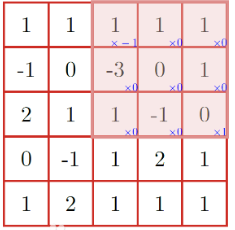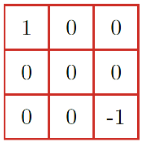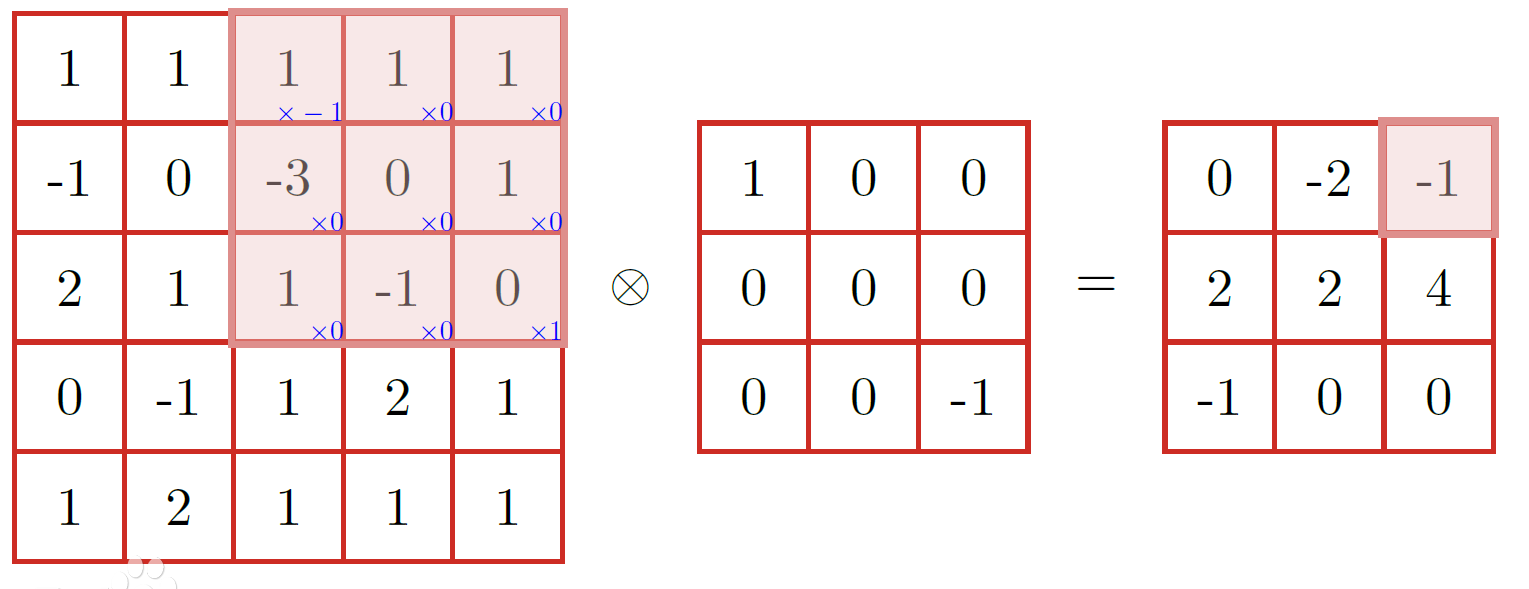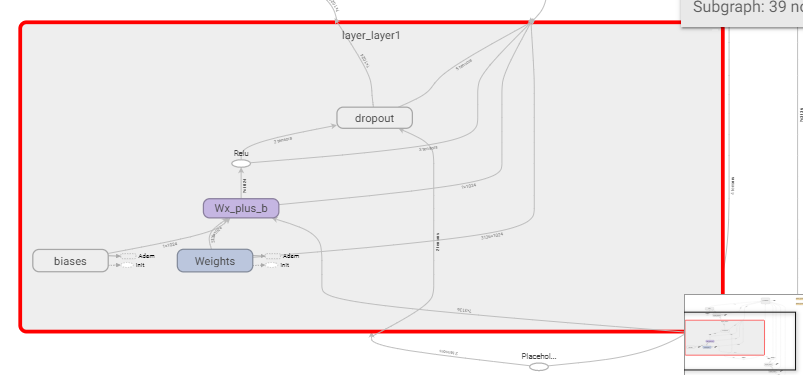神经网络学习小记录1——利用tensorflow构建卷积神经网络(CNN)
神经网络学习小记录1——利用tensorflow构建卷积神经网络(CNN)
- 学习前言
- 简介
- 隐含层介绍
- 1、卷积层
- 2、池化层
- 3、全连接层
- 具体实现代码
- 卷积层、池化层与全连接层实现代码
- 全部代码
学习前言
学习神经网络已经有一段时间,从普通的BP神经网络到LSTM长短期记忆网络都有一定的了解,但是从未系统的把整个神经网络的结构记录下来,我相信这些小记录可以帮助我更加深刻的理解神经网络。
简介
卷积神经网络(Convolutional Neural Networks, CNN)是一类包含卷积计算且具有深度结构的前馈神经网络(Feedforward Neural Networks),是深度学习(deep learning)的代表算法之一。
其主要结构分为输入层、隐含层、输出层。
在tensorboard中,其结构如图所示:
对于卷积神经网络而言,其输入层、输出层与平常的卷积神经网络无异。但其隐含层可以分为三个部分,分别是卷积层(对输入数据进行特征提取)、池化层(特征选择和信息过滤)、全连接层(等价于传统前馈神经网络中的隐含层)。
隐含层介绍
1、卷积层
卷积将输入图像放进一组卷积滤波器,每个滤波器激活图像中的某些特征。
假设一副黑白图像为5*5的大小,像这样:
利用如下卷积器进行卷积:
卷积结果为:
卷积过程可以提取特征,卷积神经网络是根据特征来完成分类的。
在tensorflow中,卷积层的重要函数是:
tf.nn.conv2d(input, filter, strides, padding, use_cudnn_on_gpu=None, name=None),其中:
1、input是输入量,shape是[batch, height, width, channels]。;
2、filter是使用的卷积核;
3、strides是步长,其格式[1,step,step,1],step指的是在图像卷积的每一维的步长;
4、padding:string类型的量,只能是”SAME”,”VALID”其中之一,SAME表示卷积前后图像面积不变。
2、池化层
池化层用于在卷积层进行特征提取后,输出的特征图会被传递至池化层进行特征选择和信息过滤。
常见的池化是最大池化,最大池化指的是取出这些被卷积后的数据的最大值,就是取出其最大特征。
假设其池化窗口为2X2,步长为2。
原图像为:
池化后为:
在tensorflow中,池化层的重要函数是:
tf.nn.max_pool(value, ksize, strides, padding, data_format, name)
1、value:池化层的输入,一般池化层接在卷积层后面,shape是[batch, height, width, channels]。
2、ksize:池化窗口的大小,取一个四维向量,一般是[1, in_height, in_width, 1]。
3、strides:和卷积类似,窗口在每一个维度上滑动的步长,也是[1, stride,stride, 1]。
4、padding:和卷积类似,可以取’VALID’ 或者’SAME’。
这是tensorboard中卷积层和池化层的连接结构:
3、全连接层
全连接层与普通神经网络的结构相同,如图所示:
具体实现代码
卷积层、池化层与全连接层实现代码
def conv2d(x,W,step,pad): #用于进行卷积,x为输入值,w为卷积核return tf.nn.conv2d(x,W,strides = [1,step,step,1],padding = pad)def max_pool_2X2(x,step,pad): #用于池化,x为输入值,step为步数return tf.nn.max_pool(x,ksize = [1,2,2,1],strides= [1,step,step,1],padding = pad)def weight_variable(shape): #用于获得Winitial = tf.truncated_normal(shape,stddev = 0.1) #从截断的正态分布中输出随机值return tf.Variable(initial)def bias_variable(shape): #获得biasinitial = tf.constant(0.1,shape=shape) #生成普通值return tf.Variable(initial)def add_layer(inputs,in_size,out_size,n_layer,activation_function = None,keep_prob = 1):#用于添加全连接层layer_name = 'layer_%s'%n_layerwith tf.name_scope(layer_name):with tf.name_scope("Weights"):Weights = tf.Variable(tf.truncated_normal([in_size,out_size],stddev = 0.1),name = "Weights")tf.summary.histogram(layer_name+"/weights",Weights)with tf.name_scope("biases"):biases = tf.Variable(tf.zeros([1,out_size]) + 0.1,name = "biases")tf.summary.histogram(layer_name+"/biases",biases)with tf.name_scope("Wx_plus_b"):Wx_plus_b = tf.matmul(inputs,Weights) + biasestf.summary.histogram(layer_name+"/Wx_plus_b",Wx_plus_b)if activation_function == None :outputs = Wx_plus_belse:outputs = activation_function(Wx_plus_b)print(activation_function)outputs = tf.nn.dropout(outputs,keep_prob)tf.summary.histogram(layer_name+"/outputs",outputs)return outputsdef add_cnn_layer(inputs, in_z_dim, out_z_dim, n_layer, conv_step = 1, pool_step = 2, padding = "SAME"):#用于生成卷积层和池化层layer_name = 'layer_%s'%n_layerwith tf.name_scope(layer_name):with tf.name_scope("Weights"):W_conv = weight_variable([5,5,in_z_dim,out_z_dim])with tf.name_scope("biases"):b_conv = bias_variable([out_z_dim])with tf.name_scope("conv"):#卷积层h_conv = tf.nn.relu(conv2d(inputs, W_conv, conv_step, padding)+b_conv)with tf.name_scope("pooling"):#池化层h_pool = max_pool_2X2(h_conv, pool_step, padding)return h_pool
全部代码
import tensorflow as tffrom tensorflow.examples.tutorials.mnist import input_datamnist = input_data.read_data_sets("MNIST_data",one_hot = "true")def conv2d(x,W,step,pad):return tf.nn.conv2d(x,W,strides = [1,step,step,1],padding = pad)def max_pool_2X2(x,step,pad):return tf.nn.max_pool(x,ksize = [1,2,2,1],strides= [1,step,step,1],padding = pad)def weight_variable(shape):initial = tf.truncated_normal(shape,stddev = 0.1) #从截断的正态分布中输出随机值return tf.Variable(initial)def bias_variable(shape):initial = tf.constant(0.1,shape=shape) #生成普通值return tf.Variable(initial)def add_layer(inputs,in_size,out_size,n_layer,activation_function = None,keep_prob = 1):layer_name = 'layer_%s'%n_layerwith tf.name_scope(layer_name):with tf.name_scope("Weights"):Weights = tf.Variable(tf.truncated_normal([in_size,out_size],stddev = 0.1),name = "Weights")tf.summary.histogram(layer_name+"/weights",Weights)with tf.name_scope("biases"):biases = tf.Variable(tf.zeros([1,out_size]) + 0.1,name = "biases")tf.summary.histogram(layer_name+"/biases",biases)with tf.name_scope("Wx_plus_b"):Wx_plus_b = tf.matmul(inputs,Weights) + biasestf.summary.histogram(layer_name+"/Wx_plus_b",Wx_plus_b)if activation_function == None :outputs = Wx_plus_belse:outputs = activation_function(Wx_plus_b)print(activation_function)outputs = tf.nn.dropout(outputs,keep_prob)tf.summary.histogram(layer_name+"/outputs",outputs)return outputsdef add_cnn_layer(inputs, in_z_dim, out_z_dim, n_layer, conv_step = 1, pool_step = 2, padding = "SAME"):layer_name = 'layer_%s'%n_layerwith tf.name_scope(layer_name):with tf.name_scope("Weights"):W_conv = weight_variable([5,5,in_z_dim,out_z_dim])with tf.name_scope("biases"):b_conv = bias_variable([out_z_dim])with tf.name_scope("conv"):h_conv = tf.nn.relu(conv2d(inputs, W_conv, conv_step, padding)+b_conv)with tf.name_scope("pooling"):h_pool = max_pool_2X2(h_conv, pool_step, padding)return h_pooldef compute_accuracy(x_data,y_data):global predictiony_pre = sess.run(prediction,feed_dict={xs:x_data,keep_prob:1})correct_prediction = tf.equal(tf.arg_max(y_data,1),tf.arg_max(y_pre,1))accuracy = tf.reduce_mean(tf.cast(correct_prediction,tf.float32))result = sess.run(accuracy,feed_dict = {xs:batch_xs,ys:batch_ys,keep_prob:1})return resultkeep_prob = tf.placeholder(tf.float32)xs = tf.placeholder(tf.float32,[None,784])ys = tf.placeholder(tf.float32,[None,10])x_image = tf.reshape(xs,[-1,28,28,1])h_pool1 = add_cnn_layer(x_image, in_z_dim = 1, out_z_dim = 32, n_layer = "cnn1",)h_pool2 = add_cnn_layer(h_pool1, in_z_dim = 32, out_z_dim = 64, n_layer = "cnn2",)h_pool2_flat = tf.reshape(h_pool2,[-1,7*7*64])h_fc1_drop = add_layer(h_pool2_flat, 7*7*64, 1024, "layer1", activation_function = tf.nn.relu, keep_prob = keep_prob)prediction = add_layer(h_fc1_drop, 1024, 10, "layer2", activation_function = tf.nn.softmax, keep_prob = 1)with tf.name_scope("loss"):loss = tf.reduce_mean(tf.nn.softmax_cross_entropy_with_logits(labels=ys,logits = prediction),name = 'loss')tf.summary.scalar("loss",loss)train = tf.train.AdamOptimizer(1e-4).minimize(loss)init = tf.initialize_all_variables()merged = tf.summary.merge_all()with tf.Session() as sess:sess.run(init)write = tf.summary.FileWriter("logs/",sess.graph)for i in range(5000):batch_xs,batch_ys = mnist.train.next_batch(100)sess.run(train,feed_dict = {xs:batch_xs,ys:batch_ys,keep_prob:0.5})if i % 100 == 0:print(compute_accuracy(mnist.test.images,mnist.test.labels))
希望得到朋友们的喜欢。
有不懂的朋友可以评论询问噢。



































还没有评论,来说两句吧...